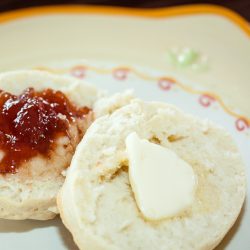These 3 ingredient buttermilk biscuits are easy and delicious. This recipes makes enough to have some now and freeze some for later baking.

My grandmother has been making these easy buttermilk biscuits for as long as I can remember, and the same dough can be used to make easy cinnamon rolls—just spread the rolled dough with melted butter and sprinkle with cinnamon and sugar, roll, slice, and bake.
This recipe makes a large batch of biscuits so you can freeze half either before or after cooking. Freezing them before cooking makes it easy to have fresh, hot biscuits for breakfast, but if you cook them first, you can make your own breakfast biscuits for the freezer instead of buying them already prepared.
Making the buttermilk biscuit dough
Combine the flour and butter, using a sturdy stand mixer (mine is a Bosch Universal) or a pastry cutter. A fork will do if you don't have a mixer or pastry cutter. Cut the butter into the flour until the mixture is crumbly.

When your flour and butter are a crumbly, even consistency, it's time to add the buttermilk.
Can I substitute soured milk for buttermilk?
Historically, buttermilk was the uncultured liquid remaining after making butter from cream, but what we commonly call buttermilk is actually cultured buttermilk and has nothing to do with production of butter. The buttermilk we buy at the grocery store is milk cultured with bacteria that produces lactic acid (which is what gives cultured buttermilk its distinctive aroma).
Although some websites recommend souring milk with lemon juice if you do not have buttermilk, this is not the time to substitute sour milk for cultured buttermilk! Real buttermilk is necessary for the distinctive flavor of buttermilk biscuits and substitutions will yield disappointing results.
Because of its high lactic acid content, I find that buttermilk tends to last quite a while past its "best by" date (which is not the same as an expiration date). If mine is past its "best by" date, I shake it up, pour a little to check the consistency (it should not be lumpy), and give it the smell test. You will be able to tell from the look and smell if the buttermilk is past its prime.
Rolling & cutting out buttermilk biscuits
Now that we've added the real buttermilk, it's time to give the dough a final mix. The photo below shows the consistency I like—the dough should not be too dry, but should be clumped together and pulling away from the sides of the mixing bowl easily.

Add more flour if too wet, more buttermilk if too dry.
When the dough is rolling consistency, knead a few times with your hands and turn out onto a floured surface.
For rolling, I really like a silicone rolling mat and a heavy marble rolling pin. The weight of the marble rolling pin makes it easier for me to get a nice consistent thickness without as much pushing as a wooden rolling pin needs.

Roll out to your desired thickness (I usually roll my dough to about ¾ to 1" thick) and cut with a biscuit cutter.
Can I use a glass if I don't have a biscuit cutter?
Although it may be tempting to substitute a glass or small bowl if you do not have a biscuit cutter, you need the sharp, thin edge of a biscuit cutter to slice cleanly so that the biscuits will rise properly. A dull edge will result in sides that seal on the edges and prevent the biscuits from rising.
After cutting out as many biscuits as possible, combine the extra dough and re-roll as many times as needed to use all of the dough. Avoid working in extra flour if at all possible.

Bake half (if you are freezing uncooked biscuits) or all (if you are freezing cooked biscuits) of the biscuits on a cookie sheet at 475° until brown, about 15 minutes (cooking time will vary based on thickness).
Can I freeze buttermilk biscuits?
You can freeze the biscuits either cooked or uncooked.
To freeze uncooked, place the other half of the biscuits in a single layer on a cookie sheet or other flat pan and put in the freezer for a few hours or until frozen. When frozen, place the biscuits into a dated freezer container for later use.
To freeze cooked biscuits, place biscuits into a dated freezer container for later use.
If assembling breakfast sandwiches for the freezer, slice cooked biscuits and fill as desired. Wrap each biscuit with freezer wrap and place biscuits in a freezer container.
To cook frozen biscuits
If cooking thawed biscuits, follow normal cooking instructions.
To cook frozen biscuits, extend cooking time to about 25 minutes (cooking time will vary with thickness).
If reheating cooked biscuits, bake at 350ºF for about 20-25 minutes or until hot. If biscuits begin to brown too much, cover with foil for remaining cooking time.
To reheat breakfast sandwiches, wrap breakfast sandwich in a paper towel and heat in microwave for 2 minutes, then flip over and heat for an additional 1-2 minutes until heated through.
Recipe

Easy Buttermilk Biscuits
Ingredients
- 4 cups self-rising flour
- ½ cup butter, softened
- 1-½ cups buttermilk
Instructions
- Combine flour and butter, cutting with a fork or using a mixer.
- Stir in buttermilk and mix well. Add more flour if too wet, more buttermilk if too dry.
- When dough is rolling consistency, knead a few times and turn out onto a floured surface. Roll out and cut with a biscuit cutter.
- Bake the biscuits on cookie sheet at 475° until brown, about 15 minutes (time will vary based on thickness).



Leave a Reply